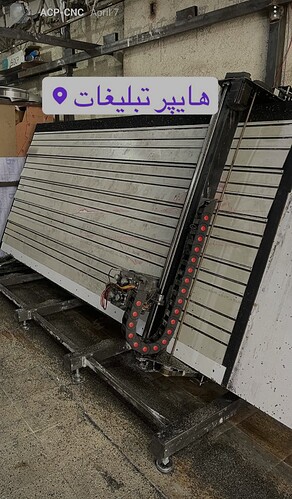I use a 1.5kw vfd and spindle, i do more so to control the rpm to correctly get my chips cutting acm, i dont think im using 1/2 of the available power in my use case. But its nice to have a water-cooled spindle when your vacuum is inside a silencer box
I have no issue with people using whatever as long as it is common knowledge that is is extreme overkill. If they made a good 500-800watt watercooled spindle you would actually be able to use much faster rapids & accelerations, sacrifice no cutting speed and save a ton of actual machine time.
Or maybe more to the point is people think more power means faster cutting, that simply is not true provided you have enough power, anything after that just slows down accels and rapids costing time.
My cutting (v-routing ) speed its 1440mm/min that’s what’s recommended for my bits, they last for more than 70 sheets each, before i killed 4 of the bits by using 1800-2200mm/min they lasted 10sheets or less. Amana acm bits arent cheap. And as i buy them in bulk isnt cheap to import to my country also.
But yes i i could find a quality/quiet spindle with less power/weight, i would not think and buy it.
Probably an high quality 500w lightweight spindle should result in a better quality and overall speed.
65mm, silent (watercooled) light and around 800w with a vfd would be great. (Preferably with reverse, so i can finally get the rapidchange atc)
Can’t speak for cutting woods, rarely i do some mdf but my shop cuts extruded pvc and acm the majority of the time
Rapidchange… ![]()
Its in my to do list but a beefier cnc its on my top 5 things to do first.
Dual spindle and vertical. (Easier to handle 5m long sheets.
For now i just use a bitsetter and some collars to get consistent z height and just pause the program, change bits and hit play?!
Yeah, I feel like that is coming to the home gammer sooner than later.
All of the math in this thread is super cool, considering I was only working with a relative test to start. Real working data is cool.
For the 10kg load, I was kind of bummed with the 1.5mm deflection if that was ⁹a realistic amount. I would find 1.5mm unacceptable for many if not most parts that I cut with the CNC.
9 lbs load fron Ryan’s post sounds good, and 5.3mm DOC and 8mm/s (4800mm/min) is way more than I am pushing now. I’m still amazed at the 3600mm/min that I’m pulling off now. Literally double what I do with the Primo.
So my sanity check is the X axis.
59Ncm torque (83.6 oz.in) motors at 2A on a 16T GT2 pulley (~5mm radius) maens that those motors can pull a shade under 118N of force, which is about 12kg.
Given that the rated 59Ncm of torque is at the full rated 2A of current, and we are using less than 1/2 of that, we are not lokking at nearly that much load being possible in the X axis. What I find on torque vs steady state current seems to indicate that “pull-out” torque on a stepper motor is directly proportional to steady-state current, so at 1A, I would expect the X motor to be able to generate about 6kg of pull, and 800mA that becomes 5kg. Everything I can find also says that torque drops off with speed, but that rate is different for different motors, so…
Okay, so call it 5kg (11 lbs) of pull available on the X axis. Anything more than that will result in skipping steps. (Most of the graphs I saw for speed drop off torque above 500RPM. Given that 1 revolution is 32mm, 10RPM is 320mm/min, 100 RPM is 3200mm/min 200 RPM is then 6400mm/min, 400 RPM is 12800mm/min, so RPM drop off (given still being able to supply the nominal power to the motor) shouldn’t be a big thing for cutting load, unless people are exceeding 16000mm/min. (Being fair I would not consider this speed out of the question on a 3D printer, and maybe a commercial CNC.)
I still expect that the length of the beam will be the largest factor in its stiffness. Then the size of the tube. Larger diameter tube will be more stiff. Other factors come after those two, including material composition. I believe that the caulking making the beam resist twist also means that it will make the strut more effective in reinforcing the beam.
Thinking about it in terms of the force able to be applied by the steppers is a great way to sanity check it. That just triggered a random thought: You can get 100kg capable hanging scales pretty cheaply. Putting one of those in line with the belt would give you belt tension +/- cutting force +/- acceleration force +/- drag. Run a cut at a steady speed in one direction, move over, run it back in the other, stop, you should have nominal +/- cutting force given that there’s no acceleration and the drag itself would be minimal (and sanity checkable by doing the same thing).
All of these discussions are making me want to build an LR4 just to try testing some of this stuff, lol.

I don’t know the right values, but one thing I notice is that when the stepper is going faster the torque is less, and it needs more Amps. An higher voltage helps.
Another point is that even if Y axis is moved by 2 steppers, when the core is cutting on one side of the workspace one stepper is mostly under load, the other one is helping a lil’.
Anyway, I think we can push the limits a bit more printing the core out of PET-CF and increasing the X amps to 1.2~1.4A and on Y/Z to 1A.
Talking about filaments, @vicious1 I completely agree with your chiose between PET-CF and PLA, but the first one is expensive(at least in EU).
I’m thinking about a core made out of PET-CF, and YZ Plate out of PETG-CF(it’s less than half the price) cause seems that those parts need less rigidity than the core, but in this way we can push the Amps higher.
Even the belts tend to stretch and contribute to deformation, we need to consider it as well.
So yes, that’s true, but the speed that most steppers seem to drop torque is around 16000mm/min, on a standard V1 build.
Yes higher VMot helps, since any electric motor is also an electric generator, and the motor moving generates voltage reverse of the motor direction, so a higher voltage is required to maintain current. (Super simplified version.) There is little evidence that anything more than 12V is required for the cutting speeds that we use, but many of us use 24V power supplies, and that’s what Ryan now puts in the kits.
I doubt this is significant for typical machine loads. While the Y axis can exert more force by means of 2 motors, it has double the belt, too. While we can make the motor force stronger eith more current, and use different materials to allow more heat, will that make for faster/better cutting?
So by my math above, 800mA current to the V1 supplied motors gives a pull force of about 5kg in the X direction, and 10kg in the Y direction. The lower force is the important one, since we can’t guarantee that maximum force is always needed in one direction. (Unless someone knows how to set up the CAM so that slotting is only ever done in Y direction. This might also be undesireable as that is the most likely axis to have deformation on a LowRider CNC.)
The upshot of all of this is that for absolute force, I have no need to test the CNC for deflection with more than about 7kg of pull. This exceeds the amount of force that I should ever see with the CNC under normal operarion, even if I overdrive the X motor current to 1200mA. Similarly, there is no need for the Y rail to need to resist more than the same 7kg of pull, though it needs to be able to do so at maximum cutting height with the router at XMin (what appears to be the worst case scenario for the partially captured Y rail.)
This puts some limits on useful testing. It also shows us how high the LR is still stable enough at. A higher gantry will show weaknesses in the XZ plates, particularly against forces on the Y axis. I can see a difference at Z home in deflection at the router collet, but have no quantitive data. That’s not really useful for my current XZ plates anyway, but lends some creedence to the requirement for metal XZ plates.
Leave alone math, try to move the X axis at 1000mm/min, and stop it with your hand, then try with 9000mm/min.
I notice that during rapids the machine is likely to loose steps easily.
Anyway we are talking about a machine that is well balanced between rigidity and power, and it don’t needs so much upgrades. The only way to go further in performance is an heavier machine, full metal with bigger motors, but it’s fun to blow ours minds with math and improvised tests ![]()
You have to factor in accelerations as well. My default configs are tuned for the vast majority of uses and the speeds we use.
If you want to go faster with the V1 standard hardware, the accels should be tuned again.
The torque curve is steadily dropping from 50rpm and beyond, at some point it falls off a cliff depending on power supply usually.
IF you actually want to go faster it is as simple as using larger pulleys.
Not exactly sure where any of this is going but, what we care about is torque at cutting speeds while under load. Fast travel only helps so much You can push it all you want but seconds is all you are going to save with travel time.
You gain speed and loose torque, it’s a short blanket
Do you know with 800mA and 24v what’s the max rpm you can reach without loosing torque?
Google nema 17 toruque curve it will give you an idea of how this works. The power peaks very early (slow RPM) after that it is always dropping.
So the answer to your question is like 25-50rpm.
Nothing this complicated is cut and dry, all tradeoffs.
Not really, it is a long curve.
There is no best answer for everyone. You can imagine after all this time our settings are pretty ideal for the majority of use cases. If you are doing something different then maybe you need other settings.
Instead of asking why we are doing things try presenting what you think is better and why and maybe we can give you a better answer then “it depends”.
